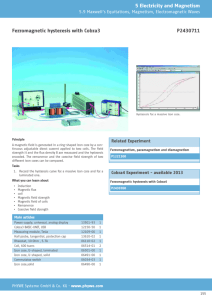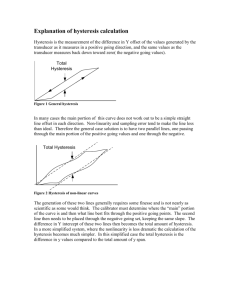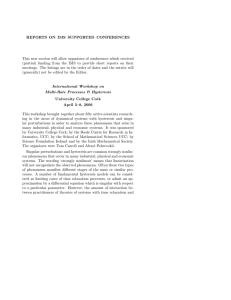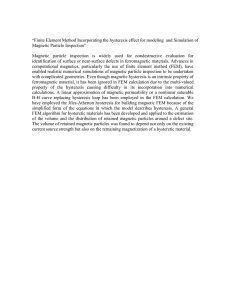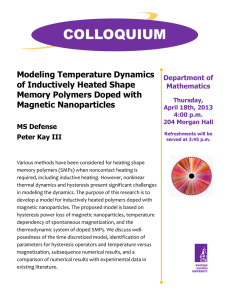Comment on “dielectric study of the ferroelectric transition of KH PO ”
advertisement
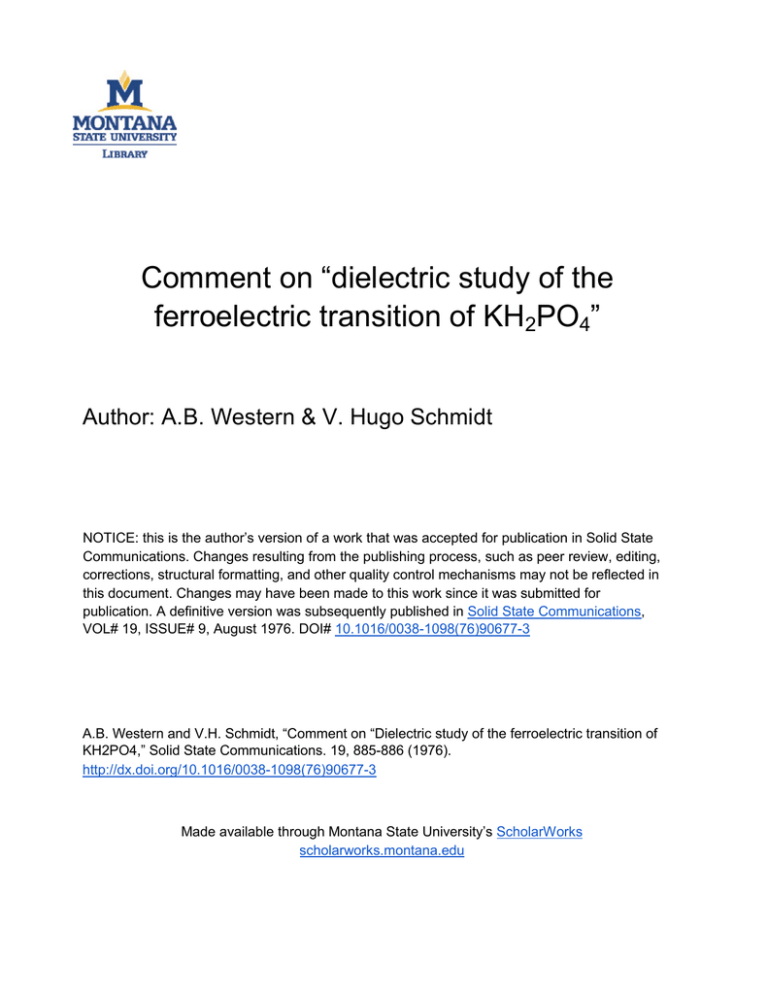
Comment on “dielectric study of the ferroelectric transition of KH2PO4” Author: A.B. Western & V. Hugo Schmidt NOTICE: this is the author’s version of a work that was accepted for publication in Solid State Communications. Changes resulting from the publishing process, such as peer review, editing, corrections, structural formatting, and other quality control mechanisms may not be reflected in this document. Changes may have been made to this work since it was submitted for publication. A definitive version was subsequently published in Solid State Communications, VOL# 19, ISSUE# 9, August 1976. DOI# 10.1016/0038-1098(76)90677-3 A.B. Western and V.H. Schmidt, “Comment on “Dielectric study of the ferroelectric transition of KH2PO4,” Solid State Communications. 19, 885-886 (1976). http://dx.doi.org/10.1016/0038-1098(76)90677-3 Made available through Montana State University’s ScholarWorks scholarworks.montana.edu Solid State Communications,Vol. 19, pp. 885-886, 1976. Pergamon Press. Printed in Great Britain COMMENT ON "DIELECTRIC STUDY OF THE FERROELECTRIC TRANSITION OF KH2PO4"* A.B. Western and V.H. Schmidt Department of Physics, Montana State University, Bozeman, MT 59715, U.S.A. (Received 19 January 1976; in revised form 24 February 1976 by 11. Suhl) We reanalyze a.c. dielectric data taken by Eberhard and Horn for KH2PO4 near T~, and obtain a much lower value of the critical bias field, near 300 V/cm in accord with results found by other workers. RECENTLY Eberhard and Horn I (EH) reported the results of their high precision measurements of the adiabatic dielectric constant of KH2PO4 (KDP) in the immediate vicinity of the paraelectric-ferroelectric phase transition at Tc = 123 K. Thermal hysteresis of the 1 kHz dielectric constant was observed to decrease with increasing d.c. bias fields. To calculate the coefficients in the Landau free energy expansion truncated at the p6 term, they used (1) their zero-bias dielectric data, (2) their hysteresis vs bias field data, and (3) the assumption that the ratio of actual hysteresis to the AT over which metastable minima of the Landau free energy exist is independent of bias field. From these coefficients, obtained from data for bias fields up to 650 V/cm, they calculated Ecr = 6500 V/cm to be the critical field at which the first-order transition line in the temperatureelectric field plane terminates. This result has received considerable interest as it agrees with the X-ray diffraction results of Kobayashi eta/. 2 who placed the KDP critical field at a similarly high value (8500 V/cm), while it contradicts the critical field values on the order of 200 V/cm found in a number of laboratories from electrocaloric, 3 isothermal dielectric, 4'5 and optical 6 studies. The purpose of this note is to point out that, if a different assumption is made regarding the origin of the thermal hysteresis observed by EH, their data may be brought into agreement with critical field values on the order of a few hundred V/cm. The reinterpretation of EH's data rests in two experiments, the first by Sugi6 et al. 7 wherein the thermal hysteresis of KDP is measured as a function of temperature scanning speed. Their results are reproduced in Fig. 1 along with the zero field hysteresis observed by EH at the temperature scan rate of 0.5 K/hr used in their experiment. EH's hysteresis is somewhat larger than would be predicted from Sugi~'s data, but not inconsistent with it. The striking feature is that 75% of the hysteresis could have been eliminated by using a slower temperature scan rate. Thus an alternative interpretation of EH's * Work supported by National Science Foundation. data is possible if one assumes that only the hysteresis for zero rate of temperature drift is caused by metastability and that the additional hysteresis is an artifact of KDP's well documented sluggish response to temperature changes in the neighborhood of the transition. The second experiment indicates that the increased hysteresis at faster temperature scan rates is due to the crystal strains not being able to follow "rapid" temperature changes. In their dilatometric investigation of the KDP transition Garber and Smolenko 8 (GS) measured the strain perpendicular to the ferroelectric c axis (It is this strain which is most intimately connected to the c axis polarization.) At a temperature scan rate of 0.03 K/hr a hysteresis of about 12 mK was observed. At a scan rate of 0.24 K/hr the strain shows almost no change with temperature whatever in a 0.05 K interval near Te, leading GS to conclude that a scan rate of 0.24 K/hr is "infinitely rapid" for the expansion of KDP in a direction perpendicular to the c axis. These two experiments indicate that the apparent hysteresis has more than one origin. First, there is the true hysteresis associated with a first-order transition. Second, finite rate of nucleation and motion of domain walls, or growth or decay of polarized "clusters", can give additional hysteresis for finite rate of temperature change. Third, finite apparatus temperature change rate near Tc can cause rapid polarization change with accompanying crystal heating or cooling by the polarocaloric effect, causing crystal temperature to lag apparatus temperature much more than is the case far from To. We have not attempted a detailed calculation of the hysteresis size such effects would produce and indeed the number of assumptions which would have to be made would render such a calculation unconvincing. We merely note from Fig. 1 that zero scanning speed hysteresis is on the order of 6 mK; from EH's data one finds that the first 6 mK decrease in hysteresis occurs at a field on the order of 300 V/cm. EH attribute the "bump" appearing above 200 V/cm to relaxational effects which increase in larger fields as Eer is approached from below. This explanation need not 885 FERROELECTRIC TRANSITION OF KH2PO4 886 I I I I v n," hi I->,.. "1" I o 0.02 • <~ 0.01 A& .AA& ~ A& A AA w I L i 0.2 I J 0.4 i T E M P E R A T U R E SCANNING SPEED, K / h r . Fig. 1. Thermal hysteresis vs temperature scanning rate, after Sugi~ et al. 7 Open circle is the value found by EH at 0.5 K/hr. be invoked, however, as the "adiabatic correction ''9 gives a deviation from Curie-Weiss behavior of just this size. 1° From the equation of state E = Ao(T-- To)P + BP 3 + CP5 one finds (es) -1 = (47r)-l[Ao(T - To) + (3B + TA2/CP)p2+ 5CP']. Using an Ao value of 7.3 × 10-3esu (EH report a value which differs by 4n) which we find necessary to fit EH's data and the specific heat at constant polarization, C e, just above the transition as reported by Benepe and Reese, n the adiabatic correction term, TA2/C P, is much larger than any reported value for 31B I. Taking the polarization value 0.1 K above Tc in a field of 500 V/cm as reported by Sidnenko and Gladkii, lz the adiabatic correction is of exactly the magnitude of the "bump" in the 500 V/cm isochamp at the corresponding temperature. Moreover, when the deviation from Curie-Weiss behavior is small, it appear to be proportional to E 2 as predic- Vol. 19, No. 9 ted by the adiabatic correction when P is proportional to E. However, on the high temperature side, the bump grows approximately as ( T - - To)-a while the linear adiabatic correction predicts ( T - - To)-2. The point here is simply that effects of the order of the "bump" in EH's data may be explained without invoking increased relaxational effects occuring as one approaches a very high critical field from below. Concerning the shape EH found for e -1 vs T curves: Landau theory predict an asymmetric "V" shape for a second-order transition. Domain wall motion will lower and flatten the low temperature half of the "W', while the adiabatic correction gives the bump just discussed. For a second order transition neither effect can cause e -1 to dip below the extrapolation of the right half of the "V" toward lower temperature. Such dips are found by EH for bias fields of 200 V/cm and below, but not for 300 V/cm and above. We consider this as evidence that Ecr > 200 V/cm for their sample. In conclusion, a different assumption regarding the decrease in thermal hysteresis with applied field yields a critical field of order 300 V/cm, with a lower limit above 200 V/cm implied by the shape of EH's e -1 vs T curves. The decrease of the dielectric constant below the CurieWeiss value is on the order of the adiabatic correction which is of a size such as to mask the sign of B which determines the order of the transition in the context of the Landau expansion. It would be of interest for this experiment to be repeated at a temperature scan rate of, say, 0.01 K/hr in a field of 500 V/cm. A critical field of 6500 V/cm would lead to a hysteresis on the order of 3 mK, well within the -+0.2 mK resolution of EH's experiment, while a 300 V/cm critical field would result in no hysteresis. REFERENCES 1. EBERHARD J.W. & HORN P.M., Solid State Commun. 16, 1343 (1975). 2. KOBAYASHI J., U E S U Y . & ENOMOTO Y.,Phys. StatusSolidi(b) 45,293 (1971). 3. STRUKOV B.A., KORZHUEV M.A., BADDUR A. & KOPTSIK V.Z., Soy. Phys. Solid State 13, 1569 (1972). 4. OKADA K. & SUGII~ H., presented at the International Conference on Soft Modes and Low lying Vibrational States and their Relation to Superconductivity and Ferroelectricity, San Juan, Puerto Rico (Dec 1975). Ferroelectrics (to be published). 5. WESTERN A.B., BAKER A.G., POLLINA R.J. & SCHMIDT V.H., ibid. 6. VALLADE M., Phys. Rev. B12, 3755 (1975). 7. SUGIE H., OKADA K. & KAN'NO K., J. Phys. Soc. Japan 33, 1727 (1972). 8. GARBER S.R. & SMOLENKO L.A., Soy. Phys. JETP 28, 1072 (1969). 9. JONA F. & SHIRANE G., Ferroelectric Crystals, pp. 38-41. MacMillan, New York (1962). 10. NAKAMURA E., TSUKAMOTO M. & ITOH K., Phys. Lett. 48A, 439 (1974). 11. BENEPEJ.W.&REESEW.,Phys. Rev. B3,3032(1971). 12. SIDNENKO E.V. & GLADKII V.V., Soy. Phys. Crystallogr. 18, 83 (1973).
